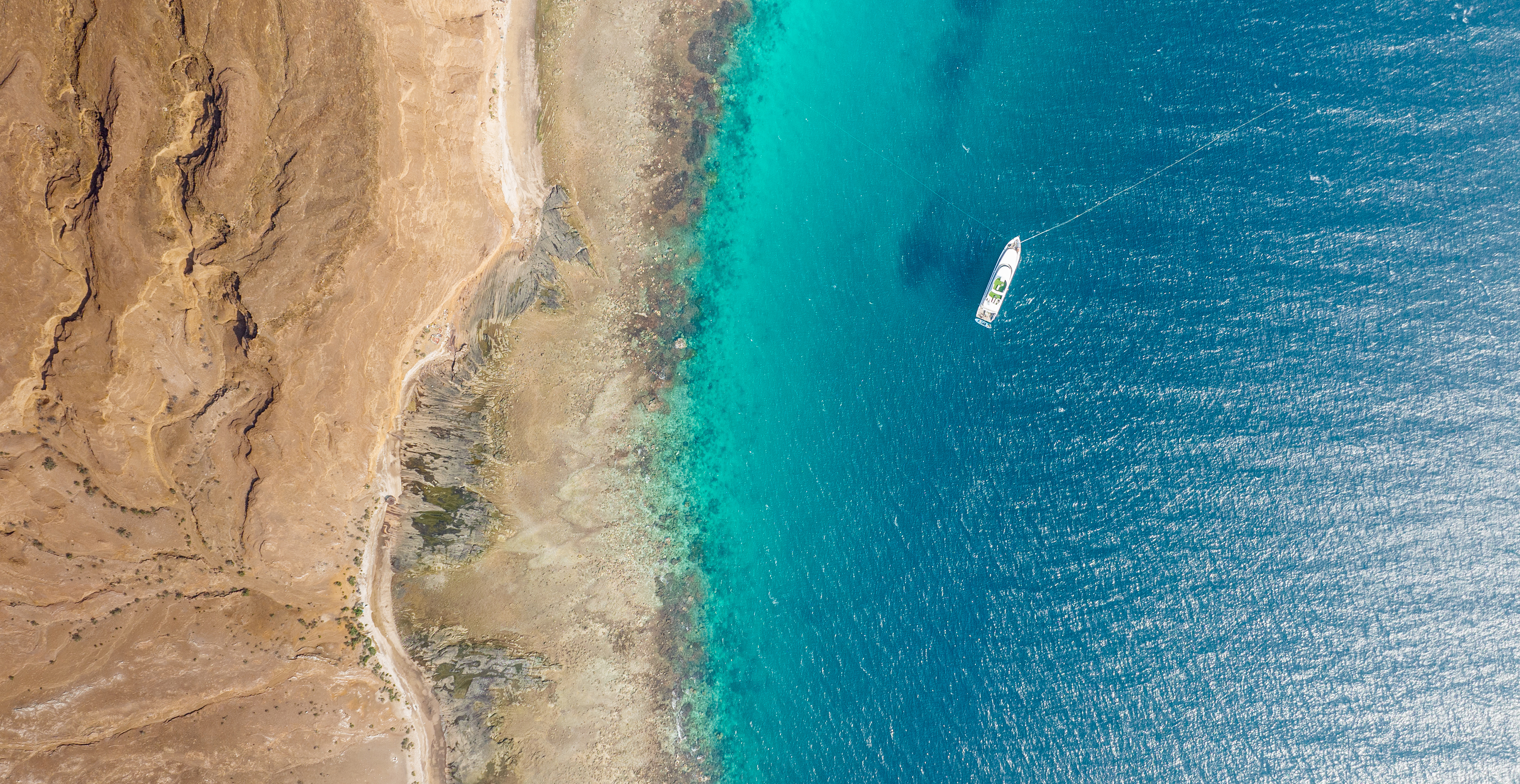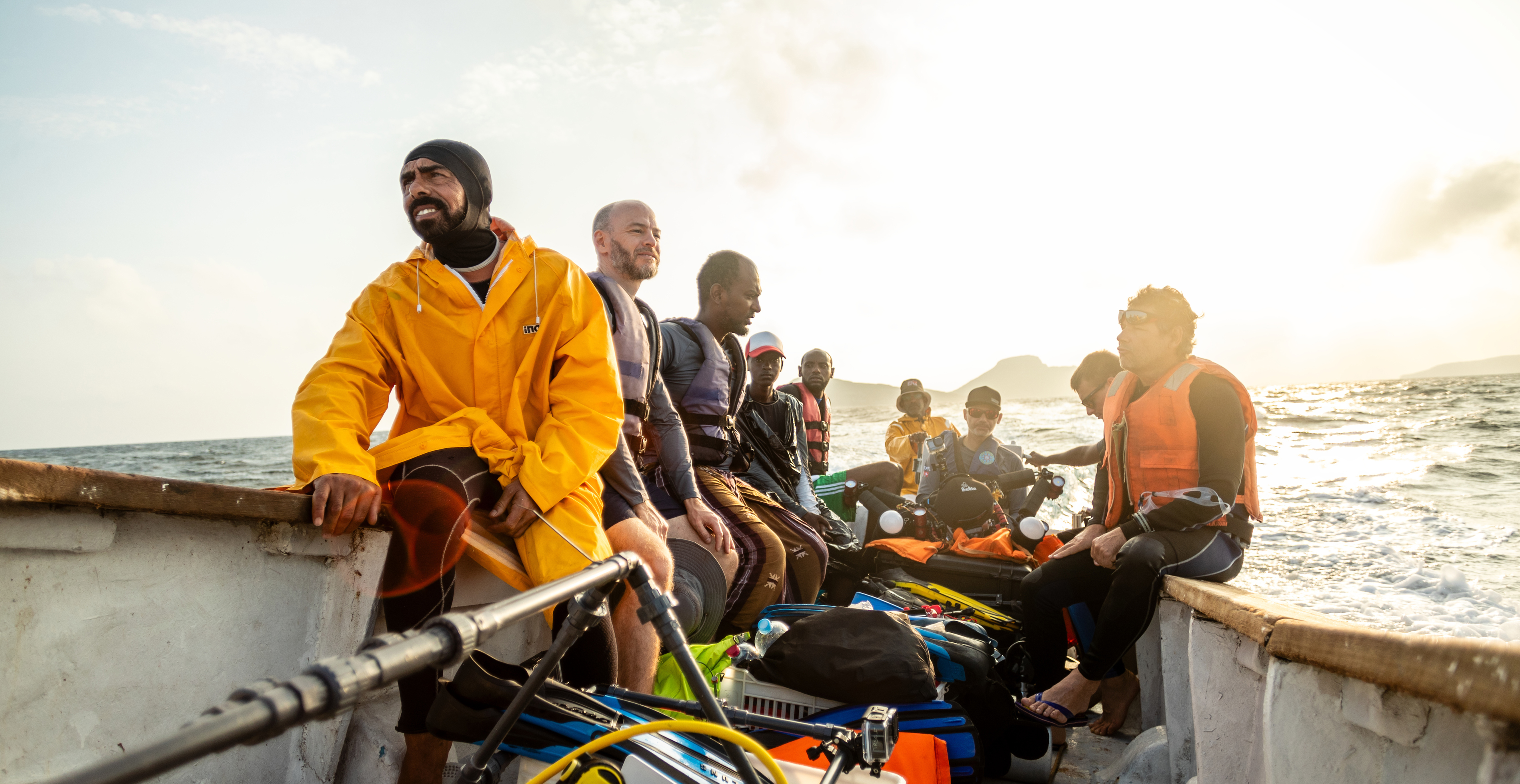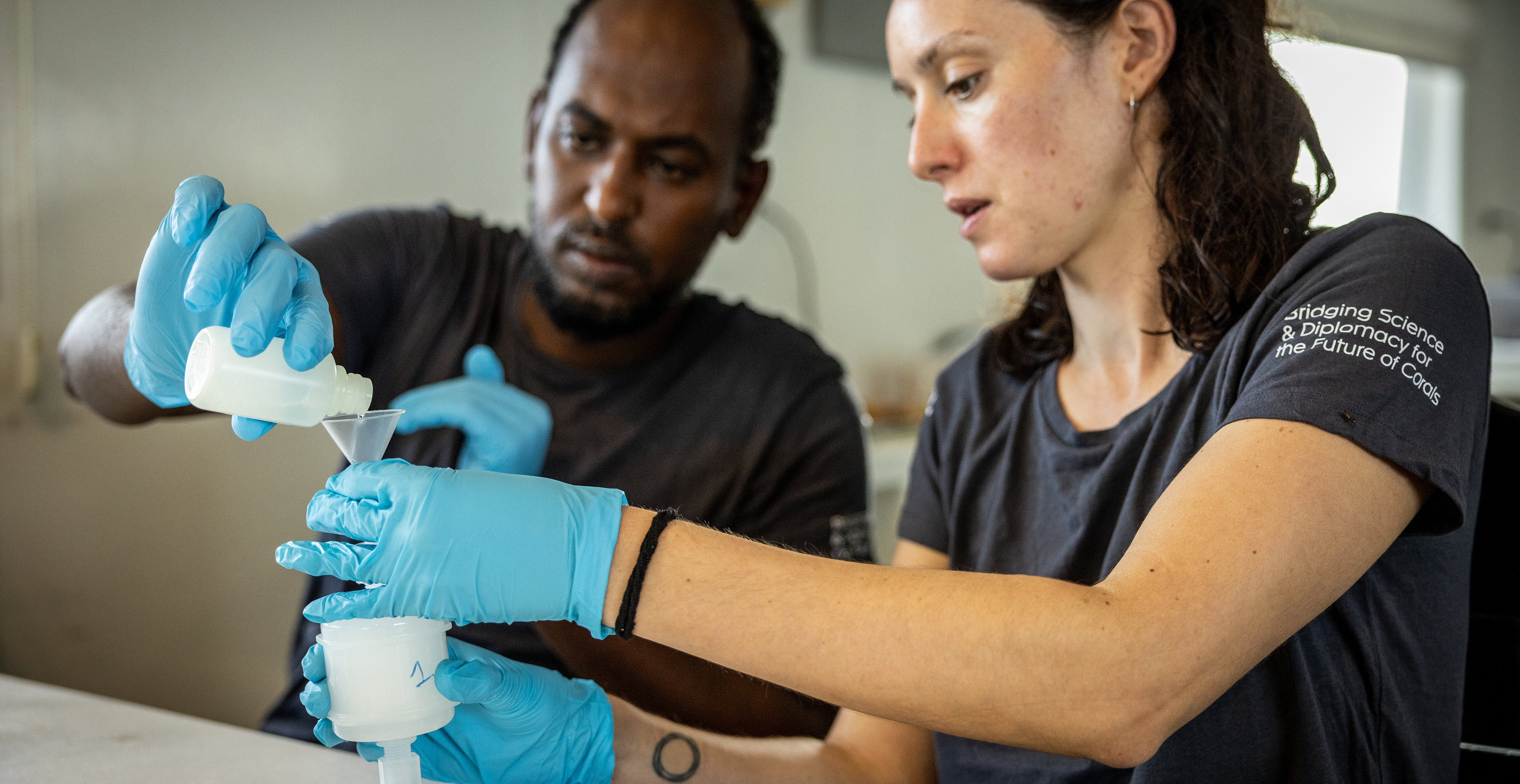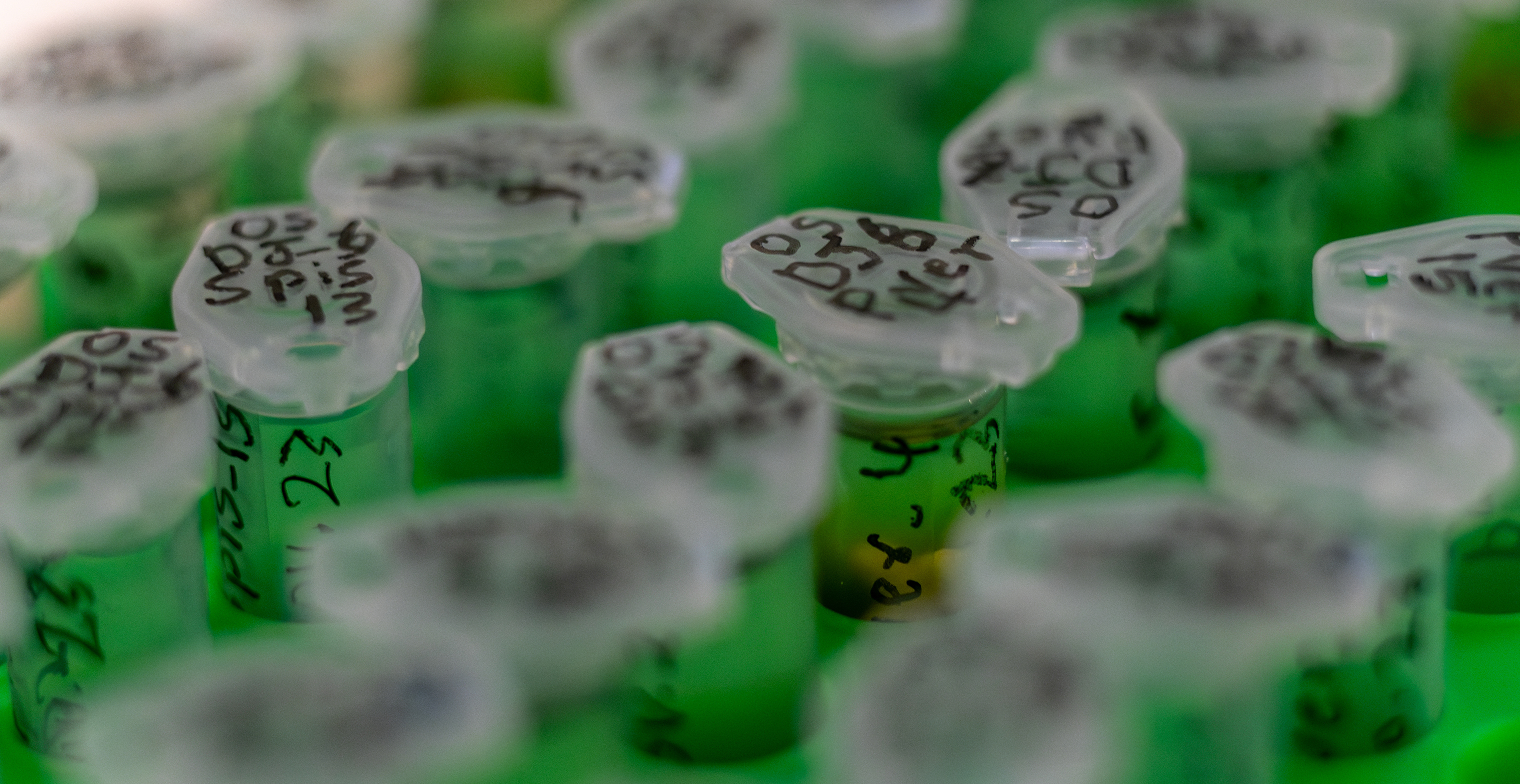
Djibouti and its port facilities seen from the Gulf of Tadjourah. This industrial setting contrasts with the wild and barren landscape of the Seven Brothers archipelago, in the Bab el-Mandeb Strait, location of the November 2023 mission.

Evening briefing and preparation for the week-long mission on board the diving boat Lucy, chartered in Djibouti. The mission led by the Transnational Red Sea Center (TRSC) in the Seven Brothers is the second one in Djibouti after the one it carried out in the Gulf of Tadjourah in September-October 2022.

Sailing towards the Seven Brothers. The archipelago is an important region for studying the potential of coral reefs in the Gulf of Aden and Red Sea to adapt to extreme local conditions, and for determining their resilience in the face of accelerated global warming.

Approaching the archipelago, between Djibouti and Yemen. The resistance of Red Sea corals to climate change is based on the hypothesis that they have retained in their genes the potential to adapt to high temperatures.

Red Sea corals are believed to have developed such a resistance to thermal stress when, over several hundred years, they recolonized the Red Sea from the Indian Ocean at the end of the last Ice Age.

As corals slowly made their way northwards from the Indian Ocean through the Bab el-Mandeb Strait, they faced extremely hot water temperatures.

The resistance of Red Sea corals to high temperatures was established in 2013 in a pioneering study by Prof Maoz Fine from the InterUniversity Institute for Marine Sciences in Eilat.

This resistance was then confirmed by a second study in which EPFL participated in 2017, leading to the creation of the Transnational Red Sea Center two years later.

The TRSC conducted its first field mission in Djibouti (Gulf of Tadjourah) in 2022 in collaboration with the Ministry of the Environment and Sustainable Development, the University of Djibouti and the Centre d’Etudes et de Recherches de Djibouti.

The 2023 field mission to the Seven Brothers archipelago once again brought together the same local partners.

Kadda Dâbali island, in the north-east of the archipelago, with its 114-meter-high summit. The archipelago itself is made up of six volcanic islands stretching some ten kilometers from east to west off the coast of the Obock district, in Djibouti's territorial waters.

From the Seven Brothers islands, one could almost see the Yemeni coast on the Eastern shore of the Bab el- Mandeb Strait.

Apart from rare scientific missions, the archipelago is well known to fishermen on both shores of the Red Sea…

… and to seabirds also attracted by the abundance of fish.

Morning gearing up before the day's first dives. TRSC’s partners Prof. Osama Saad (left) and diving technician Mustafa Khalafallah (right) from the Red Sea University in Port Sudan are checking their equipment.

The Red Sea University in Port Sudan has been a partner of the TRSC since its first joint mission off Port Sudan in September 2021.

Five scientific programs were conducted during the mission: 3D mapping; environmental DNA; genomics of marine landscapes; analysis of micro-plastic and heavy metal pollution; diversity of coral symbionts (organisms living in symbiosis with corals, such as micro-algae that provide color and, above all, nutrients).

Preparation of the material for dives in shallow waters.

Heading towards the diving site…

… sometimes in calm seas…

… or in rough seas. For this spectacular picture, Ulrika Larsson was nominated among the finalists of the Ocean Photography of the Year 2024 Award, Human Connection section.

Finally on site! The dives are about to start.

Djama Goumaneh, from Djibouti's Ministry of Environment and Sustainable Development, prepares to dive to collect sediment samples as part of the program on plastic and heavy metal pollution of coral reefs.

The team in charge of 3D mapping is receiving its equipment composed of GoPro cameras installed on a simple rig. This new mapping technology was developed by EPFL PhD student Jonathan Sauder with his supervisor Prof. Devis Tuia.

The overall good health of the coral reefs of Djibouti and the Red Sea contrasts sharply with the catastrophic situation of corals elsewhere in the world, victims of massive bleaching episodes because of global warming, the main cause of their inexorable disappearance.

The health and vitality of a coral reef can be measured by the diversity of living organisms it shelters, such as fish and invertebrates. Here, clownfish playing in an anemone.

It is generally accepted that coral reefs host 25% to 30% of all marine species worldwide.

Despite being in good health, Djibouti corals can also be subject to bleaching episodes. One of the objectives of the mission to the Seven Brothers was to quantify the coral cover of the various islands and determine the proportion of bleached and dead coral.

Coral bleaching is caused by the breakdown of the symbiotic relationship between corals (transparent polyps with white carbonate calcium skeleton) and the micro-algae living in its tissues that provides color and essential nutrients. It is a result of cyclical or systemic stress linked to rising water temperatures.

Divers film a segment of reef as part of the 3D mapping program using a new artificial intelligence methodology developed by EPFL's Laboratory for Environmental Computer Science and Earth Observation.

Based on images taken by simple GoPro-type cameras, an artificial intelligence developed at EPFL and specially trained to recognize different types of coral reef substrates can reconstitute 3D reefs in a few minutes, with a quality far superior to the spatially limited, slow and inaccurate current techniques.

In the Bab el-Mandeb Strait, the sea around the Seven Brothers archipelago can be rough and treacherous due to the violent currents that flow through this narrow stretch of water.

This bleached coral bears witness to the stress that can affect the fragile symbiotic relationship between this animal organism and the algae that provides its color - and nutrients.

These fragments will later be analyzed as part of an RSU program to study the diversity of organisms living in symbiosis with corals.

Prof. Osama Saad and diving technician Mustafa Khalafallah from the Red Sea University (RSU) in Port Sudan collect small coral fragments along the coast of Hamra Island.

TRSC’s scientific director Dr Guilhem Banc-Prandi displays the results of a coral sample collection as part of the Seascape Genomics program. Its aim is to assess the adaptive potential of 4 hard coral species (Stylophora pistillata, Porites lobata, Pocillopora verrucosa and Acropora hemprichii) to warming waters.

A purple Acanthaster starfish feeding on a coral. An impressive species that can grow up to 80 cm in diameter, it is one of the natural predators of coral. One of the objectives of the mission was to identify Acanthaster species in order to better understand their population structure.

EPFL PhD student Manon Pribille collects mucus samples from echinoderms (bottom-dwelling animals such as sea stars, sea urchins or sea cucumbers), which will be genetically analyzed as part of a research program to establish the biodiversity of coral reefs.

Dr Guilhem Banc-Prandi, scientific director of the TRSC, takes a mucus sample from a sea cucumber as part of the echinoderm diversity program.


Researcher Ahmed Ali from the Centre d’étude et de recherche de Djibouti (CERD) samples seawater as part of a project to study the physical parameters of water: salinity, temperature, oxygen levels, etc.

Researcher Djama Goumaneh from the Djibouti Ministry of the Environment and Sustainable Development (MEDD) focuses on quantifying the concentrations in heavy metals and micro-plastics of the reef waters of the country.

Dr Ibrahim Souleiman, researcher and professor from the University of Djibouti and Dr Guilhem Banc-Prandi from the TRSC operate the pump used to collect seawater samples in order to identify – after filtering – the DNA traces of the various marine organisms in the ecosystem as part of the environmental DNA metabarcoding program.

The eDNA program, in collaboration with Prof. Loïc Pellissier of the Federal Institute of Technology Zurich (ETH Zurich), aims to assess the biodiversity and relative abundance of coral, echinoderm and fish species along the Red Sea coast on a large scale, and to establish a baseline for subsequent time series.

Gabriela Perna from the TRSC is rewinding the 100-meter line used in a 3D reef mapping session.

As the 3D mapping transects are geo-referenced, the method allows to monitor the evolution of the diversity, richness and health of the corals through subsequent mappings at the same location.

Prof Devis Tuia, head of EPFL's Laboratory of Environmental Computer Science and Earth Observation (ECEO), at the end of a 3D reef mapping session, using the new methodology developed within his lab.

Through the field missions, one of the TRSC's ambitions is also to foster direct bilateral collaborations between academic partners in Red Sea countries. Here from left to right, Dr Ibrahim Souleiman from the University of Djibouti, Mustapha Khalafallah and Prof Osama Saad from the Red Sea University in Port Sudan.

The TRSC managed to maintain its scientific collaboration with its partners of the Red Sea University in Port Sudan, established in 2021, despite the situation in the rest of the country.

Back to Lucy liveaboard boat after a diving session. The work continues with the packaging and storage of the samples collected for each program.

Dr Guilhem Banc Prandi, scientific director of the TRSC, packs a batch of coral samples (fragments of around 5 mm) taken during a previous dive.

Mustapha Khalafallah (left) and Prof Osama Saad (right) of the Red Sea University in Port Sudan, together with Prof Anders Meibom, director of the TRSC, preserving coral fragments in pure alcohol.

The coral fragments were then transported to EPFL, where their DNA was extracted before being sequenced in Switzerland at the Genomic Technologies Facility (GTF) of the University of Lausanne.


TRSC’s scientific assistant Gabriela Perna processing seawater samples taken as part of the environmental DNA (eDNA) metabarcoding program, that aims to establish the biodiversity and abundance of species in a given region.

Djama Goumaneh (left) and Gabriela Perna (right). The biodiversity and abundance of species in a given region can be established by analyzing the DNA traces they leave in the environment such as skin shedding, scales, mucus, eggs, sperm, blood or defecation.


Dr Ibrahim Souleiman, from the University of Djibouti, packs samples as part of a research program on echinoderm biodiversity (animals living on the seabed such as starfish, sea urchins or sea cucumbers).


Dr Abdillahi Houssein of the University of Djibouti filters seawater to measure its concentration of micro-plastics and heavy metals.

From left to right, Djama Goumaneh from the Ministry of Environment and Sustainable Development, Dr Ibrahim Souleiman and Dr Abdillahi Houssein from the University of Djibouti, filtering seawater samples as part of the program on micro-plastic and heavy metal pollution of coral reefs.


Prof Osama Saad of the Red Sea University in Port Sudan, here packing samples, has taken part in various scientific missions organized since 2021 by the TRSC in Sudan, Jordan and Djibouti, along with other Sudanese colleagues.



EPFL PhD student Jonathan Sauder, developer of the new 3D artificial intelligence coral reef mapping technology, analyzes the results of his dive. This new technology represents a true revolution on a global scale, given its phenomenal potential in terms of results, time and cost.

EPFL PhD student Manon Pribille packs coral samples due to be genetically analyzed as part of the Seascape Genomics program investigating the adaptive potential of corals to climate change.

The Seascape Genomics program aims to establish a model for predicting the adaptive potential of different coral species to environmental change at the scale of an entire reef system, by categorizing each species according to its “strong” or “weak” potential.


From left to right: Ibrahim Suleiman, Djama Goumaneh, Lukasz Larsson Warzecha, Manon Pribille, Ulrika Larsson, Jean-Michel Roux, Guilhem Banc-Prandi, Osama Saad, Fabiano D’Amato, Devis Tuia, Anders Meibom, Abdillahi Houssein, Jonathan Sauder, Gabriela Perna, Mustafa Khalafallah, and Ahmed Ali.

Mission accomplished, sailing back towards Djibouti after an intensive week. EPFL PhD student Jonathan Sauder shares a moment of well-deserved relaxation with Prof Osama Saad of the Red Sea University in Port Sudan.

Bye-bye Bab el-Mandeb Strait and Seven Brothers islands.

Time has come to rest for the team of 16 scientists, photographers and videographer from eight nationalities (Denmark, Djibouti, France, Germany, Sudan, Sweden, Switzerland, United Kingdom) who took part in the mission.

No more corals but a few dolphins along the way back to Djibouti.

Leaving the Lucy and its crew does not mean that the mission is completely over.

Mission accomplished, sailing back towards Djibouti after an intensive week. EPFL PhD student Jonathan Sauder shares a moment of well-deserved relaxation with Prof Osama Saad of the Red Sea University in Port Sudan.

After the field work, it’s time to share some first outcomes, and inspire a new generation of scientists at the University of Djibouti.

Dr Ibrahim Suleiman entertains a group of students about the mission and marine science. The researcher was also one of the coordinators of the mission together with Dr Sadat Said Saleh from the University of Djibouti, and Djama Goumaneh, from Djibouti’s Ministry of Environment and Sustainable Development.

Since 2023, the TRSC has helped the University of Djibouti setting up a Bachelor’s degree in Marine science. In April that year, it co-organized with the University a first educational workshop attended by some 110 Bachelors students.

Dr Guilhem Banc Prandi, scientific director of the TRSC.

Researcher Djama Goumaneh (left) from the Djibouti Ministry of the Environment and Sustainable Development (MEDD), and Dr Abdillahi Houssein of the University of Djibouti.

EPFL PhD student Jonathan Sauder talks about his 3D mapping technology, which has been used by the TRSC in the Red Sea (Jordan, Sudan, Djibouti) since 2022.

EPFL PhD student Manon Pribille talks about her research on Seascape Genomics based on a new method combining remote sensing of changing conditions in the marine environment using satellite data with genetic data from corals living in these conditions, obtained by deep sequencing of their genomes.

Prof Osama Saad of the Red Sea University in Port Sudan.

The aim of these post-mission presentations is to awaken the students’ passion for protecting the environment, and to inspire vocations for the marine biology course at the University of Djibouti newly created with the help of the TRSC.